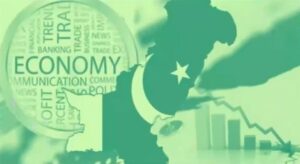
By Raja Amer Iqbal
The federal government has implemented their budget 2024-25 on 1st July 2024 with a hope to steer the country’s economic crisis into stability and progress.
Although 17 days of discussions in parliament were just a ritual process making parliament just a rubber stamp whereas, in our neighborhood the Indian parliament is mandatory to discuss budget for 75 days and in England it is 90 days.
The claim of the government is that through this budget, our GDP will grow by 3.6% and will bring prosperity across the country. This claim has irk many Pakistani citizens as they are facing the brunt of inflation and unemployment in the economy. The ongoing polarization and uncertainty in the political arena and further aggravated law and order situations have further added miseries in public life.
I, as a student of economics and business practitioner, think that Pakistan’s economic meltdown is a result of a continuous process due to our wrong socioeconomic policies where one factor is always missing and one factor remained prominent irrespective of any political or a military regime. The missing factor is “REALITY,” and the factor remained positioned as linchpin in our governance system is “adhocism.”
Although the Pakistan stock exchange is on unprecedented surge but when analysed, the fact revealed that a few sectors like banking, energy, and fertiliser, etc, excelled due to windfall profits earnings this year. These huge profits are mostly attributed to government high borrowing from the commercial banks due to unprecedented fiscal deficit.
Similarly, due to huge capacity charges paid in the energy sector, around two trillion rupees were transferred from public pockets to a few IPPs. Besides huge investment made by government owned enterprise “state life insurance” amounting over Rs 50 billion coupled with US dollars 110 million in foreign portfolio investment have created a surplus cash liquidity in PXS which led to huge corporate buyback share activity keeping the index upward trend. Due to positive signals coming from the IMF staff meeting, the government took a few prior steps in the federal budget and also added investors’ confidence in the stock exchange.
The government also claimed 2 to 3 billion dollars increased in exports this fiscal year but didn’t reveal that due to heavy rains and Indian government policy not to export rice in regular quantity created a readymade market space for our extra rice export worth over dollar two billion.
The tight measures taken by the army chief to curtail dollar smuggling also reflected an 8 percent increase of remittances through legal channels.
All these achievements are based on circumstantial evidences but not on solid economic indicators.
The reality is that in fiscal year 2023-24, the FBR failed to meet their revenue target in the sales tax head, and FBR was in shortfall of over Rs.550 billion. Similarly, they have seen shortfall in their collections in the custom duties and FED. FBR achieved an additional Rs 654 billion in income tax collection over the targeted revenue . The total collection in income tax revenue was Rs 3053 billion around Rs.1850 billion came through withholding income tax and over Rs 950 billion through advance income tax, so the rest difference of Rs 250 billion is through FBR efficiency. This shortfall of collection in sales tax also clearly depicts a reduction in business activities across the country. That’s why this year, our investment in GDP ratio was recorded 13% the lowest in the last 50 years of Pakistan history. The increased income tax revenue came through further borrowing due to an unforeseen increase in the fiscal deficit, which in return increased the commercial banks’ interest payments, resulting in an increase in their income tax payments.
These are the few harsh realities on the ground. The performance of FBR can be replicated with any other government department or even institution. This scenario is increasing distrust of people in the state organs but also have increased their concern on the expenditure side. We have seen last year an increase in government employees (staff and officers) salaries by 35 and 30 percent and this year by 25 and 20 percent respectively. Besides many exemptions in taxes and unprecedented increase in their perks. This trend is creating visible division between placing at one side the protected government employees including politicians, elite capture like big landlords and few business tycoons who are less than 2% of total population and the other side consist of general people, SME and individual businesses, individual taxpayers, few large scale manufacturers and salaried class in the private sector. In fact, out of over five million businesses, 4.7 million businesses consist of small and medium enterprises. Today, more than 87% of the workforce is employed in the SME sector, excluding the agriculture sector in Pakistan.
Instead of creating some “ease of doing business” for them through the federal budget, their upper slab of income tax has been increased from 35 percent to 49.5 percent making it the highest in the region and also among the developing countries across the world. Similarly, for the salaried class, the upper limit of 35 percent is kept intact, but the surcharge of 10 percent has been imposed. Besides radical changes in the tax percentages in the existing slabs in order to extract the maximum income tax from them.
Inspite of all existing financial burden and difficulties the protected segment of government and state are totally reluctant to adopt any meaningful austerity in their spending and expect the other side to keep on raising revenue for their ongoing extravagance of current expenditure.
Similarly, inspite of the fact that in Pakistan it is a well known practice that almost 1/3 project cost is usually siphoned off in corruption and embezzlement, the total amount announced in the federal and provinces budgets for development projects are around Rs 3500 billion this is perhaps the highest in the history of Pakistan at a juncture where country need to save every penny and shall discourage every unnecessary spending.
The amount of around Rupees thirty trillion is announced in federal and four provincial budgets that is almost 1/3 of our total GDP value on top of it our federal budget has a 2% primary surplus that mean after excluding public debt interest servicing rest all current expenditures including defence and exorbitant increases in salaries and perks etc will be paid through further borrowed money.
The revenue targets are not only difficult but rather impractical in the doldrum economic scenario. Therefore, unless the government cuts their expenditures, otherwise the projected fiscal deficit will go up exponentially and will add further burden on the already non- sustainable internal public debt adding further to debt servicing repayments which have already reached the critical level.
We need to realize that the clock is ticking if we don’t mend our way of handling the economic issues. Then perhaps Pakistan will be left far behind in the region, not only economically but also in many other spheres of life. The country where 45 percent of the population is living below the poverty level, full of economic distortions and broadly dividing the population into two parts. One part is suffering and facing harshness due to the increasing high cost of living mostly attributed to the contemporary state cross subsidies policy and their ruthless spending based on borrowed money. This fiscal year government is targeting to collect 40 percent more total revenue inclusive of 64 percent increase in the non-taxed revenue through government fees, penalties, fines and profit earnings of regulatory authorities namely NEPRA, DRAP, SECP, CCP, SBP and CCA etc coupled with nonstop increase in energy prices will fetch negative ramifications on the cost of doing business in Pakistan and may further deteriorate economic scenario.
These are a few harsh realities on the ground that mostly emerged due to the adoption of the “adhocism” approach in the decision-making at all echelons of command across the country.
Now, let me quickly narrate a few measures needed to succeed a better way forward.
Firstly, we need inclusive economic development not just for less than two percent of the population. We all must adopt austerity and discourage all types of corruption and malpractices through appropriate legislations to create space for meritocracy.
Secondly, we must adopt horizontal and vertical equity, which means everyone must pay income tax irrespective of the source of income, and income tax must be progressive in nature, and no one should be protected and exempt
Thirdly, the government must evolve workable mechanisms to ink “charter of economy” with all political parties in consultation with stakeholders like Chambers of Commerce and industry etc and this charter shall be passed as legislation in the parliament with 2/3 majority.
Fourth, the government must introduce pragmatic structural reforms to promote industry and SME through meaningful consultation with the stakeholders.
Fifth, the government must evolve workable and acceptable economic solutions in the energy sector for the ongoing circular debts and capacity charges.
Sixth, we must address major hindrances impeding our educational and health services in the public sector. Otherwise, the percentage of stunted population in Pakistan will become unsustainable in the next few years’ time.
Seventh, the government must adopt permanent policy to eradicate extremism and terrorism from the country. In the contemporary scenario, no direct foreign investment is possible to come into Pakistan through the market mechanism. Yes, G to G is possible because these are mostly backed through state sovereign guarantees but real FDI is always in the private sector through market based feasibility but unfortunately nowadays multinational companies are leaving Pakistan due to drastic decrease in disposal income of Pakistani citizens along with evolving deterioration in security situations. The unstable Pakistan currency coupled with few other deteriorating economic factors are among the major reasons.
Eight, state bank must lower the markup and keep check on inflation rate besides stabilize the Rupee exchange rate based on long-term strategy in order to enable the business community to make business plans on long term basis to create more job opportunities so to enhance per capita income and increase GDP growth in the country. Pakistan needs almost two million new jobs per annum for the white and blue collar workforce. This can only be possible through the vibrant and growing private sector.
Ninth, the half population of Pakistan consists of females therefore the government must devise practical and pragmatic policy to empower women not only economically but also encourage them through structural reforms to take an active role in general politics and other spheres of influence.
Tenth, government, through political consensus, must evolve a mechanism to revisit the NFC award or devise practical mechanisms where provinces need to share the burden of public debt repayment.
Eleventh, the government must adopt transparent and accountable privatization processes at the earliest to get rid of SoEs and also dismantle the layer of departments for the repetition of work in order to reduce existing unsustainable government footprint. A poor country like Pakistan can’t afford paying around Rs 6 trillion in salaries and pensions at the collective level of federal and provincial governments in a year. (The writer is a former President of RCCI and an economic analyst besides business practitioner . He is an M.PHIL GPP and MSc in economics from NDU and QAU Isb and MBA Fin UK).


